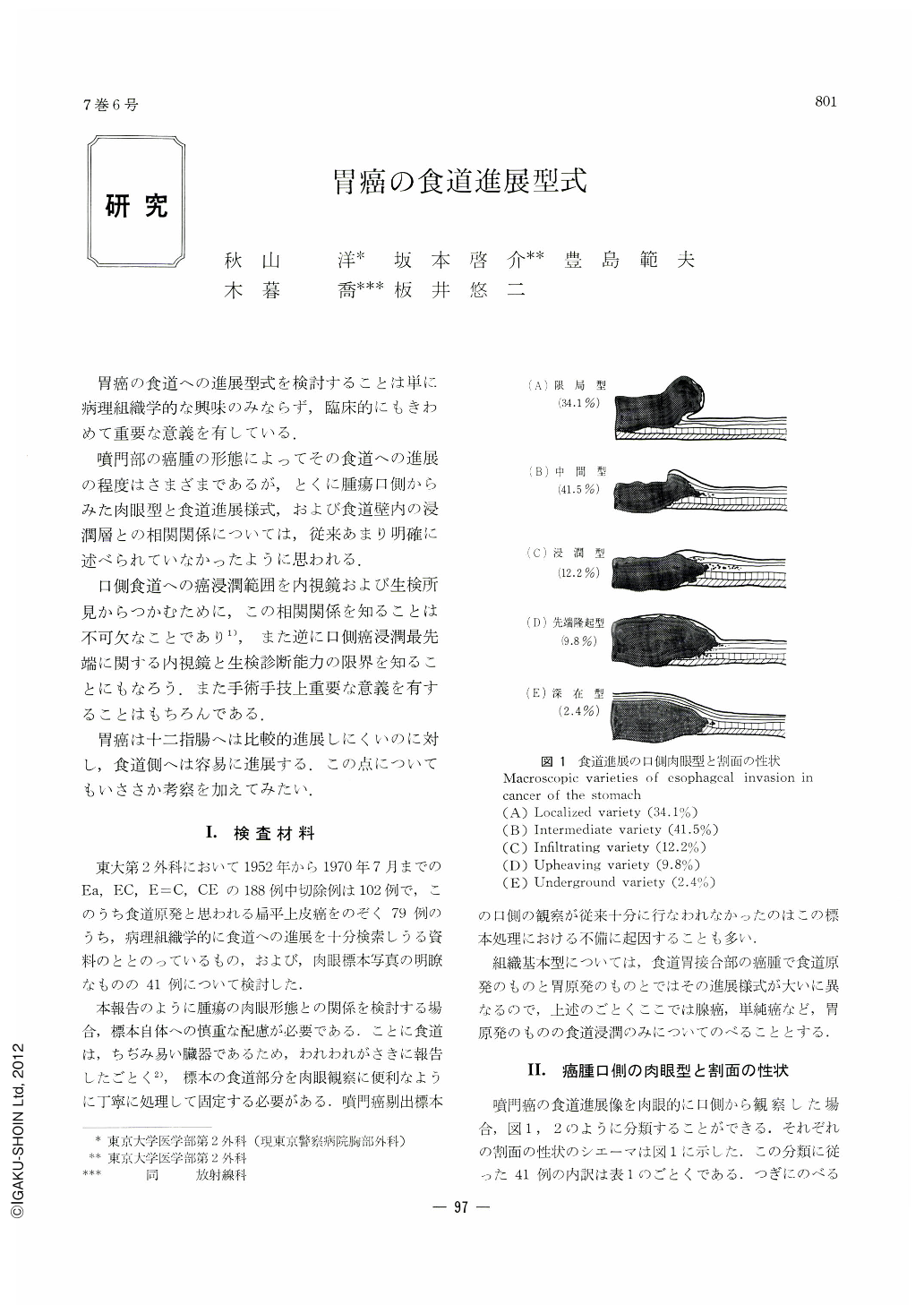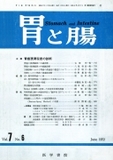Japanese
English
- 有料閲覧
- Abstract 文献概要
- 1ページ目 Look Inside
- サイト内被引用 Cited by
胃癌の食道への進展型式を検討することは単に病理組織学的な興味のみならず,臨床的にもきわめて重要な意義を有している.
噴門部の癌腫の形態によってその食道への進展の程度はさまざまであるが,とくに腫瘍口側からみた肉眼型と食道進展様式,および食道壁内の浸潤層との相関関係については,従来あまり明確に述べられていなかったように思われる.
Analysis of the mode of esophageal invasion in cancer of the cardia of the stomach is very important not only in the view point of histopathology but also in practical surgery.
Fourty one cases of cancer of the cardia originated in the stomach side were analysed. Esophageal invasions in those cases were divided into the following five varieties according to macroscopic appearances. Those types are somewhat different from the routine classification of the macroscopic appearances of gastric cancer probably due to reaction of the esophageal mucosa. Those are (A) localized variety (34.1%), (B) intermediate variety (41.5%), (C) infiltrating variety (12.2%), (D) upheaving variety (9.8%) and (D) underground variety (2.4%).
Localized variety easily far exceeds the esophago-gastric junction. Its average macroscopic distance from the junction is 3.6 cm. However, microscopic cancerous invasion beyond border of the tumor is rare. The most common histological type in this group is adenocarcinoma papillotubulare. Common routes of invasion in the esophageal wall are lamina propria mucosae and submucosa. The esophageal epithelium is pushed up by expansive growth of the tumor and becomes atrophic and is thinned and finally is penetrated by tumor nests. Biopsy specimen taken from the surface of the tumor sometimes shows normal or atrophic esophageal mucosa, as is different in gastric carcinoma
Intermediate variety is usually associated with cancerous ulcer. Its common type of histology is adenocarcinoma tubulare. Invasion is usually located deep in the layer of submucosa. Average distance of microscopic invasion exceeding border of the tumor is 0.5 cm. Diagnosis of extent of tumor infiltration by biopsy specimen is difficult because the covering esophageal epithelium is usually intact.
Infiltrating variety is most difficult in diagnosing the extent of esophageal invasion. Its most common layer of invasion is submucosa and in some cases muscularis propria. This fact makes the diagnosis by biopsy specimen difficult. Its average microscopic distance from the macroscopic tumor border to the microscopic end of the tumor is 1.0 cm. This means that about 3.0 cm of the apparent normal esophageal wall from the macroscopic tumor border should be resected.
Upheaving variety has very characteristic “finger like” appearance. Rather expansive growth upheaves the esophageal mucosa. It is thinned, becomes atrophic and finally is penetrated by tumor nests. Biopsy sometimes shows normal or atrophic esophageal mucosa. Common layers of invasion are lamina propria mucosae and submucosa.
Underground variety is rare. It is difficult to determine the tumor border by macroscopic observation. The tumor invades through muscularis propria in the esophageal wall. The esophageal epithelium is usuall normal.
Margin of resection should not be decided only by palpation, but preferably be determined by careful direct observation of mucosa through esophagotomy to obtain the margin of resection negative for cancer.

Copyright © 1972, Igaku-Shoin Ltd. All rights reserved.


